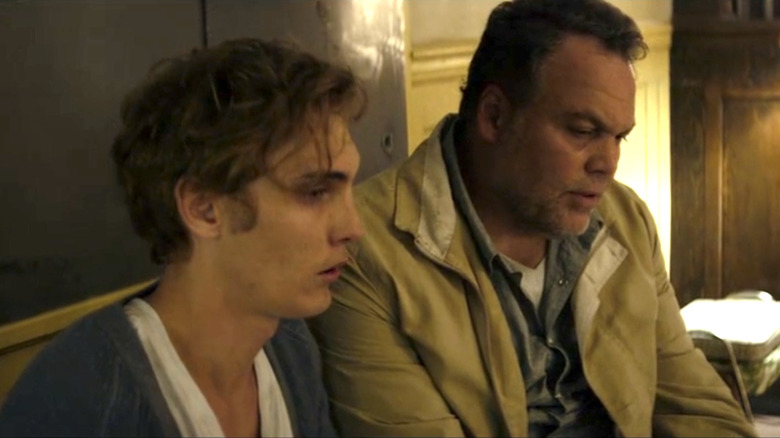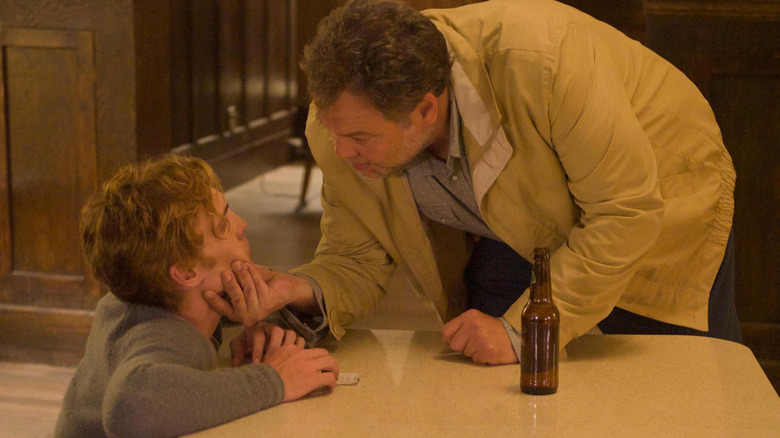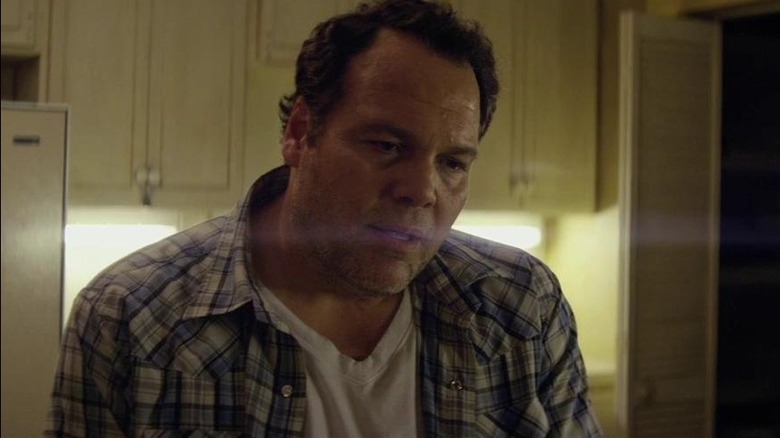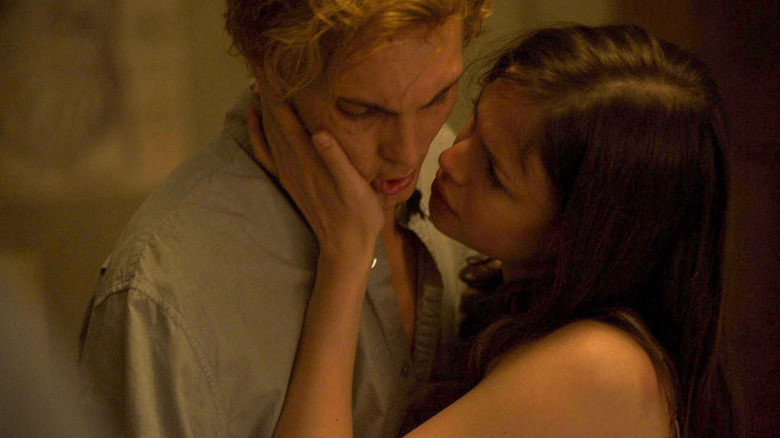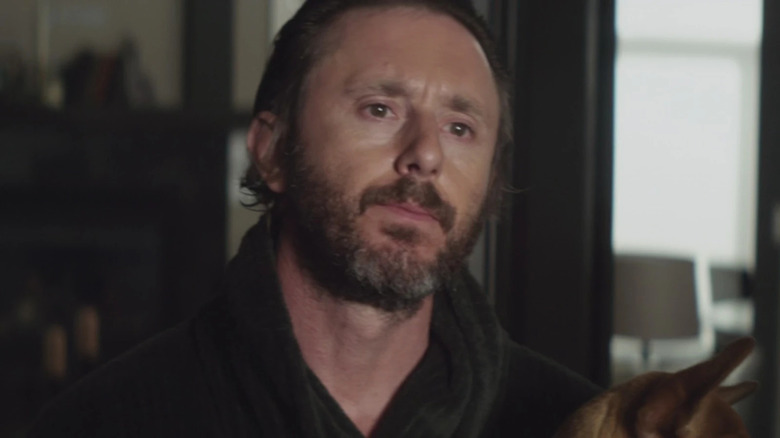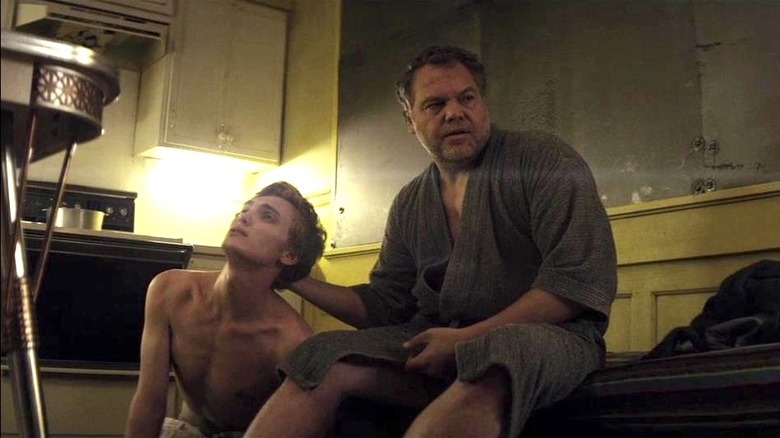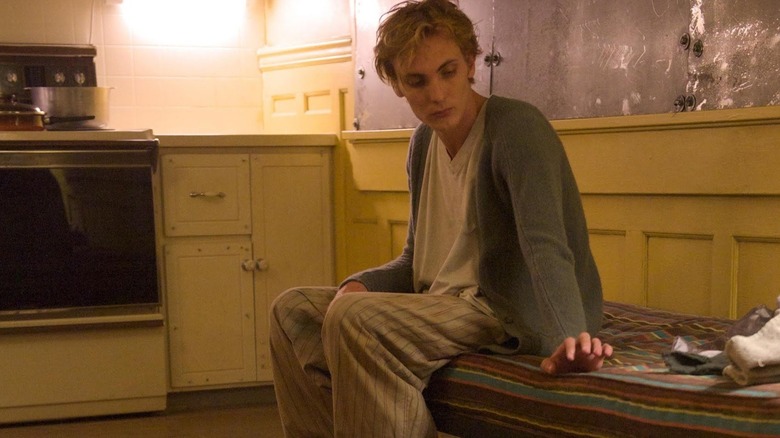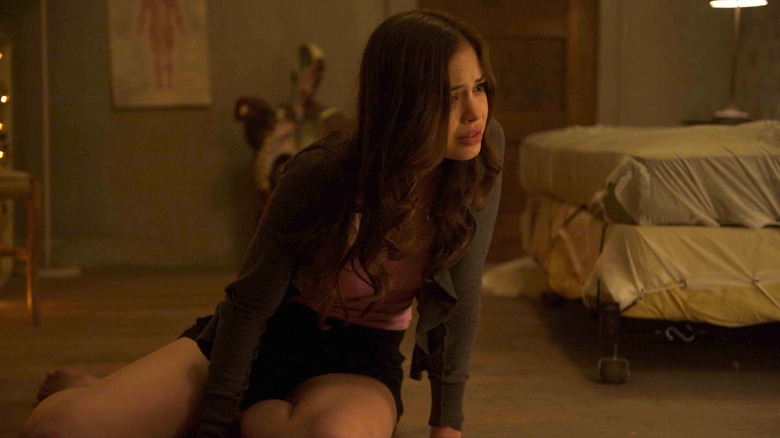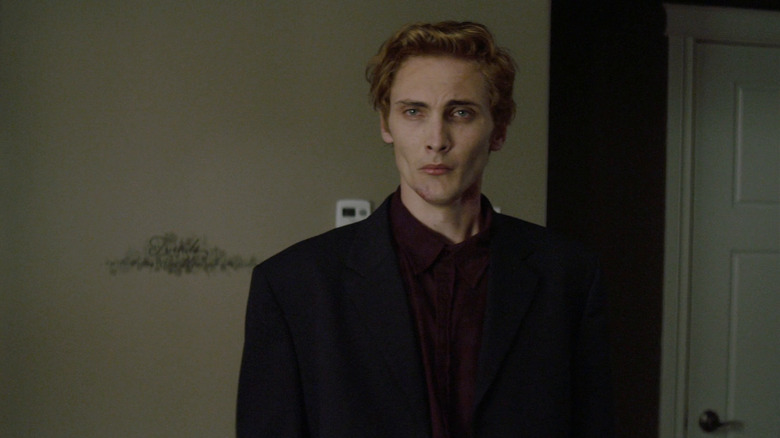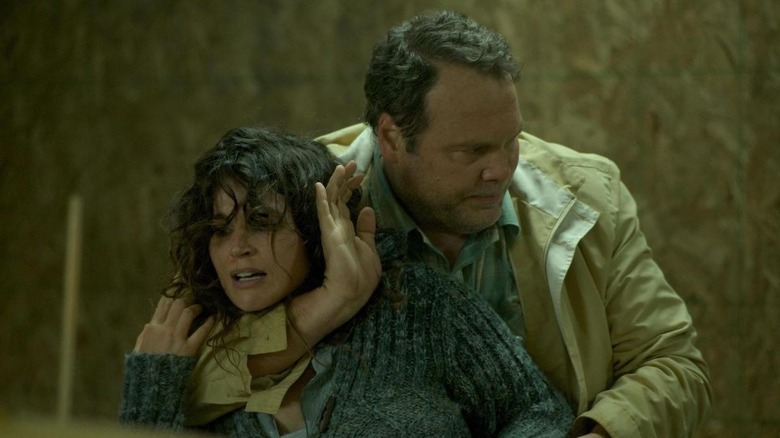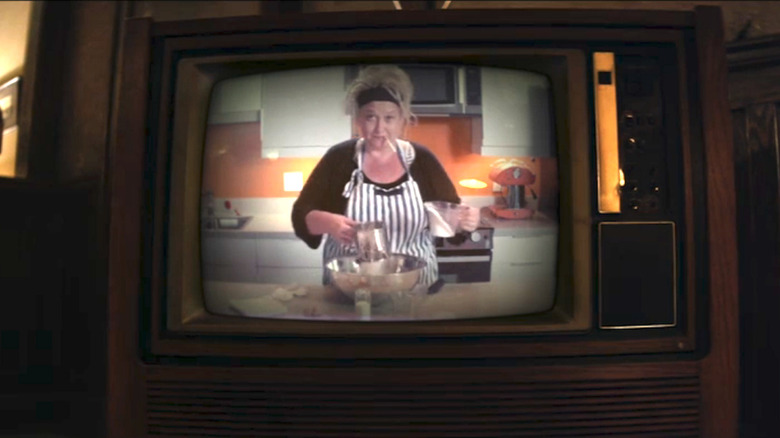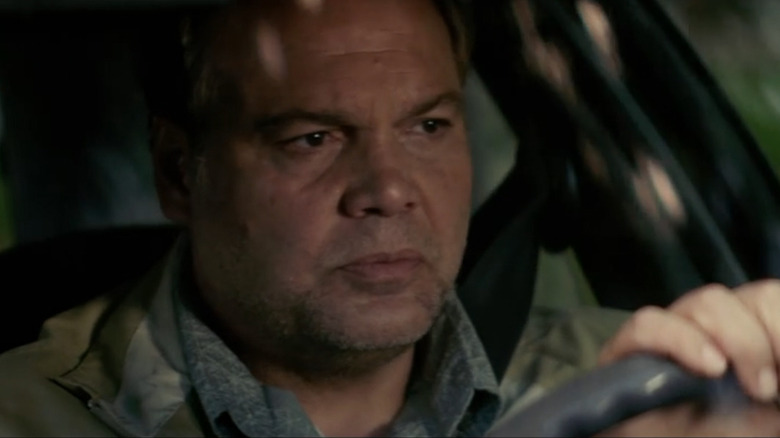The Ending Of Chained Explained
Mostly overlooked when it was first released in 2012, "Chained" is a blend of psychological thriller that borders on horror starring Vincent D'Onofrio, Eamon Farren, and Jake Weber. Directed by Jennifer Lynch — daughter of "Twin Peaks" creator and auteur filmmaker David Lynch — the film is the sickening story of a serial rapist and murderer who grooms a young captive boy to become his successor.
D'Onofrio plays Bob, a slow-witted but brutally vicious madman who has been kidnapping and slaughtering women. His newest target is wife and mother Sarah (Julia Ormond) and her young son Tim (played by Evan Bird in the first act). After Sarah is discarded, Bob decides to keep Tim as his personal servant, so he grows up in captivity, under the thumb of a dangerous killer. A decade later, when he's given the unexpected chance to finally escape his tormenter, Tim (Farren) discovers that putting an end to his nightmare isn't as easy as it seems.
With some complex story elements and a blood-curdling climax — not to mention a jaw-dropping plot twist — "Chained" may need a little explanation to be fully understood. Be warned: the film is not for the faint of heart.
This article discusses violence, sexual assault, incest, and other topics that may be sensitive to some readers.
What you need to know about Chained
"Chained" begins with Tim, a 9-year-old boy in a run-down house. When he hears the buzzer of the house door, he goes racing to unlock it. What enters, however, tells us right away that this is no ordinary drama. A burly man named Bob bursts into the house holding a screaming woman hostage. Flashing back two months, we discover that Tim had been abducted by Bob, a taxi driver and serial sexual predator who murdered Tim's mother Sarah, and has held him hostage since, giving him the name 'Rabbit' and forcing him to help in his twisted murder spree.
Flashing forward many years, Rabbit is now an adult, and is kept chained to the wall, where he assists in cleaning up after the murder of Bob's female victims, and burying their bodies in a crawl space. Now that Rabbit is all grown up, Bob decides to mentor him, teaching him his own deranged life lessons, in the hopes of turning him into a killer just like him. Bob views Rabbit as his son and wants to see the boy follow in his footsteps as a serial killer: hunting down women in the streets, raping them, killing them, and keeping a scrapbook of their path of death.
If you or anyone you know has been a victim of sexual assault, help is available. Visit the Rape, Abuse & Incest National Network website or contact RAINN's National Helpline at 1-800-656-HOPE (4673).
Bob's past is revealed
At first glance, "Chained" might appear to be part of the "torture porn" genre of films, but features less graphic violence than the likes of "Saw" or "Hostel" and other movies of that ilk. Instead, the focus of the movie is squarely on the disturbing predatory relationship between the killer Bob and his child assistant Rabbit, and the strange bond he feels toward the boy he views as his son. Throughout the film, we're also given brief glimpses into Bob's past that almost make him a sympathetic figure.
Following a scene where Bob witnesses a father verbally berating his teenage son, we see a flashback to Bob as a teen himself, who comes home from school with his younger brother. Teenage Bob is apparently working an after-school job, which enrages their father, who was recently laid off from work. In one of the film's most shockingly brutal scenes, Bob's father takes out his rage by beating his son and forcing Bob to have sex with his own mother. It's a traumatic moment that would shape the rest of Bob's life and turn him into a vengeful monster with a hatred for women.
If you or anyone you know has been a victim of sexual assault, help is available. Visit the Rape, Abuse & Incest National Network website or contact RAINN's National Helpline at 1-800-656-HOPE (4673).
Rabbit's escape
Once Bob decides to indoctrinate Rabbit into his world of killing, he begins to teach him about human anatomy and the most efficient ways to kill. Then he abducts Angie, an innocent 18-year-old woman who Bob locks in a room with Rabbit, expecting him to have sex with her before killing her in cold blood. The troubling choice for Rabbit is clear: Will he become the sexual predator and woman-hating killer that Bob has taught him to be? Or will he show mercy and find a way to escape Bob's years of killing and torment? Ultimately, Rabbit chooses the latter: he tricks Bob into thinking he's killed Angie by stabbing her in a non-vital organ and hiding her in the crawlspace alive.
The next night, Bob takes Rabbit out of the house for the first time since he was abducted, hunting for new victims. But after Bob catches Rabbit trying to secretly signal for help, he realizes that Angie is still alive and races home to finish her off. In a nail-biting climax, Angie is able to slice Bob with a box cutter just before Rabbit enters and stabs Bob to death. When he buries his abuser in the crawlspace, he places one of the scrapbooks of Bob's victims above his shallow grave.
If you or anyone you know has been a victim of sexual assault, help is available. Visit the Rape, Abuse & Incest National Network website or contact RAINN's National Helpline at 1-800-656-HOPE (4673).
The truth about Rabbit's abduction
To the audience's surprise, Rabbit's escape from Bob's clutches isn't the end of the film, and there's a second, more sinister conclusion that still awaits. After his escape, Rabbit — who has now reclaimed his name as Tim — seeks out his father, Brad Fittler. The day that Tim had been abducted, Brad had insisted that his wife and son take a cab home rather than a bus because it would be safer, meaning their abduction was inadvertently his fault. That's not why Tim has come seeking him out, though. In the aftermath of Bob's murder, he learned that Brad's involvement in their kidnapping was more than just a tragic mistake.
Arriving at his father's new home — where he has remarried and has a new son — Tim shows his father a letter he found in Bob's belongings. It's then revealed that their initial encounter with Bob all those years ago was no coincidence, because Brad is the younger brother that Bob had endured his father's abuse to protect. Worse still, Tim has learned from Bob's letter that Brad had paid his brother $10,000 to kidnap and murder his wife Sarah, so he could be free to start a new life.
In the wake of this revelation, Brad attacks his son, but his new wife intervenes, stunned by the betrayal and years of lies. Brad turns his rage on his new wife, but Tim is able to overpower him, and kills his father in a brutal beating.
What does it all mean?
According to director Jennifer Lynch, the theme that sits at the heart of "Chained" is the idea of how a monster is made. While the movie never tries to soften the horrific nature of Bob's crimes — going to great lengths to show just how unhinged, dangerous, and evil he really is — it also provides context for how became the man he is. The question that the film also raises, more than once, is whether the child of abuse can ever escape the cycle of violence present in their lives.
As we saw from Bob's upbringing, his own father was physically, emotionally, and sexually abusive, beating little Robert Fittler and forcing him to have sex with his mother. With such a brutal childhood, Bob suffered his own personal torment and turned his psychological trauma into a hatred for women, which he expressed through serial rape and murder. When it came time to serve his brother's needs, Bob took his nephew Tim and tried to raise him to perpetuate the cycle of violence, grooming him to become a killer just like him. Throughout the film, we are faced with the reality that while Rabbit has remained steadfast to maintain his innocence, he may be inexorably becoming the same as his abuser.
If you or someone you know may be the victim of child abuse, please contact the Childhelp National Child Abuse Hotline at 1-800-4-A-Child (1-800-422-4453) or contact their live chat services.
Does Tim continue the cycle of abuse?
From the age of nine until his adulthood, young Tim Fittler was subjected to the barbaric cruelty of his uncle Bob. Beaten, starved, and kept isolated from the world, he was kept chained up within the confines of a small house located in a remote area of Nebraska where there wasn't a soul around for miles. Forced to participate in the rape and murder of countless women, his identity was stripped away, until he became little more than a frightened animal who Bob called Rabbit.
The question the film asks, though, is whether Rabbit can ever escape not just his physical confinement in Bob's home but also the cycle of violence that often passes from one generation to the next. Though he does manage to turn the tables on his uncle, murdering him and burying him beneath the house, the film closes on a somewhat ambiguous note, without a clear answer as to whether Rabbit becomes an abuser himself. While he may have attempted to save Angie's life, and killed his abuser, there are sounds during closing credits that suggest that he may have taken Bob's place as a cab driver and abductor of women. Thankfully, director Jennifer Lynch addressed this ending more directly in interviews — but more on that later.
If you or someone you know may be the victim of child abuse, please contact the Childhelp National Child Abuse Hotline at 1-800-4-A-Child (1-800-422-4453) or contact their live chat services.
Unanswered questions from Chained
Whether Tim can escape the cycle of abuse isn't the only question that is left unanswered at the conclusion of "Chained." In fact, there are a number of elements that aren't so neatly tied up, that may have audiences questioning what comes next. Most notable is the fate of the many victims that Bob had collected over the years, who sit buried beneath his rural home. While it stands to reason that Tim would have gone to the authorities, there is no such suggestion that this occurred, with the young man standing alone at the house when the credits roll.
But if Angie — the woman who he had helped escape — got out alive and well, as the ending of the movie suggests, did she not go to the police and tell them of her ordeal? Or did Tim swear her to secrecy? If so, why? Likewise, Brad's wife had told Tim to leave their home after the deadly confrontation with his father, calling the police and blaming her husband's death on a random burglar. But surely the authorities wouldn't have blamed Tim for acting in self-defense, nor would they be likely to put the responsibility of Bob's rape and murder victims on him, when he was a child prisoner and unwilling participant.
If you or anyone you know has been a victim of sexual assault, help is available. Visit the Rape, Abuse & Incest National Network website or contact RAINN's National Helpline at 1-800-656-HOPE (4673).
The script originally had an a very different ending
As it turns out, when director Jennifer Lynch first came aboard the film, it was more focused on sex and violence. Originally filled with graphic, bloody torture scenes, Lynch decided to strip most of it out of the film. "I was really intrigued by the idea of a killer who drove a taxi cab and the kidnapping of the boy," Lynch told the This Is Horror Podcast. "But I didn't gravitate toward the way the man killed, there was no understanding of the killer within that."
That's not all Lynch altered, though. It sounds like in the original version of the movie, Bob was actually caught for his rape and murder spree. "There was an entire B-story where detectives were pursuing the killer of all these women," Lynch revealed. "To me it was a lot more frightening to think of Bob getting away with it." Ultimately, Lynch decided to cut the entire chase for the killer and the graphic torture: "I removed the detectives because I've seen that movie, I hadn't seen this one. I wanted to deal more with the actual people rather than cutting pieces of women off and letting them die slowly, that just seemed unnecessary to me."
That's not all, though. Another ending from Lynch's version of the story that didn't make it into the film would have revealed that the area surrounding Bob's home had become a thriving suburban neighborhood during the 10 years of Tim's captivity. "I just couldn't afford the CG," Lynch said of the unfilmed ending.
Hidden meanings in Chained
Removing the gratuitous sex and violence wasn't the only alteration director Jennifer Lynch made to the script before production began on "Chained." In the same This is Horror interview, she noted that major tonal and thematic changes were made to the movie that some viewers may not have even noticed. One was turning the film into a claustrophobic story set almost entirely within the confines of the house.
As Lynch puts it, she liked the idea of the audience being stuck in the house right alongside Rabbit so they could feel a little bit of what he felt, never seeing the outside world. "The only time we leave there is in bits and pieces when Bob goes out or when they go out together," Lynch said. "We are just as captive as Rabbit is."
There was also some symbolism at play in the murder victims. "Each death I think represents how Bob suffers and what he thinks power is and what he thinks hurts. Sometimes to impart wisdom on the boy in a terrible way he kills."
What has director Jennifer Lynch said about the ending of Chained?
During the press tour for "Chained," Jennifer Lynch did a number of interviews where she talked about the making of the film. She hasn't been shy about what the story meant to her. But in a chart with Hey U Guys, Lynch elaborated on the ambiguous ending of the film and the questions of whether Angie is alive and whether Tim/Rabbit became a killer himself.
"I love a bit of uncertainty at the end of things," Lynch told the outlet. "It allows for dialogue and audience involvement after the movie." She has used such open-ended conclusions in other films, and decided to leave the door open for questions on "Chained," too. "I adore the different views on what might become of someone who has survived such things. What happens next. Will the love they knew once be the thing that echoes, or will the violence be too loud? ... If we can save children from abusive situations, we can begin to end the cycle of the abused becoming abusers. Until then, our silence and hands in our pockets, only keep the monsters coming."
But what about those ominous sounds heard over the credits, of Tim cutting out newspaper clippings, getting into the cab, and opening the garage door? Does this mean he's taken Bob's place as a killer? "The sounds of Rabbit in the house over the end credits were really important to me. He returns to the only home he has now. He does what he knows. But in my opinion Angie is fine. Next stop, IKEA."
An alternate cut of Chained?
Even after director Jennifer Lynch did a major rewrite of the script, the final version of "Chained" was still drastically different than what she had imagined. Forced to remove chunks of her own film by the studio for a variety of reasons, Lynch still dreams of one day getting to assemble a director's cut of "Chained" that restores her original vision.
"I would adore to do a director's cut," she told Hey U Guys. "I was limited by a running time requirement and had to lose some things I loved. There was a scene as well that I lost due to feelings the distributors had about it. I miss it terribly." Worst of all, however, is that the ending may have suffered most from trimming down the movie. "The ending was cut significantly enough that Jake Weber [who played Brad] told me he was a bit heartbroken to see what was missing from that final scene with Rabbit."
Even without the original torture scenes in the original script, the MPAA still slapped them with an NC-17 rating that forced them to remove more graphic sequences. "Ultimately what they kept saying was, 'It just feels too real ... we don't think children should ever see it.'" But Lynch felt the movie's message was important, especially to teens. "To say that a 16-year-old cannot go with a parent or discerning adult and after the movie have a dialogue about abuse and safety and the horror of actual violence... is absurd to me."
